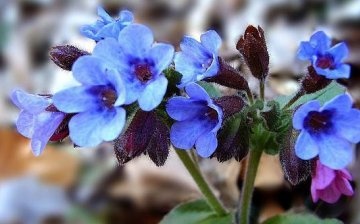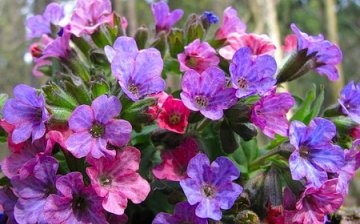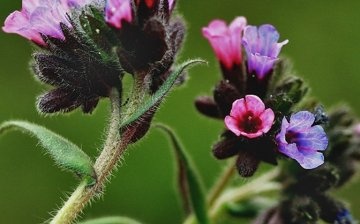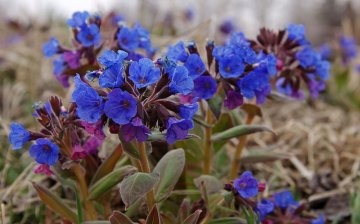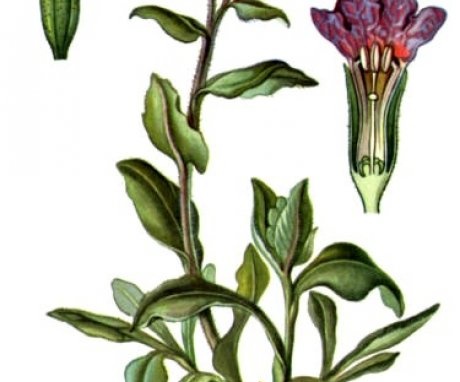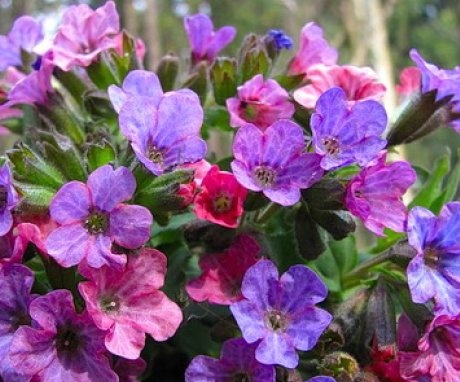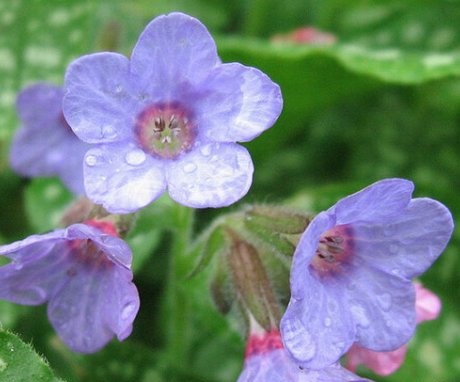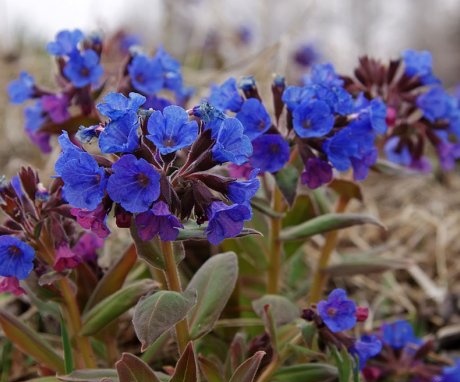Lungwort: description, properties and growing of a flower
Earlier, in the old days, the lungwort flower was considered the humble primrose of the forests. It was on the forest edges that this unique flower appeared after the snow melted. Literally, ten years ago, no gardener dreamed of growing this plant at home. But now, thanks to breeders, the flower beds of many gardeners are full of various types of lungwort.
Scientists have made the leaves of the plant decorative. And now, after the flowering of lungwort in the flower beds, the decorative leaves of the plant, which have a great variety, are pleasing to the eye. These leaves can have specks, specks, dots, a chaotic pattern. The edges of the leaves are either wavy or rectilinear. The breeders even achieved that the lungwort flower began to bloom longer, extending its flowering period to 30 days. The sizes and shades of flowers have changed. But it is still a gorgeous honey plant and perennial.
Content:
- Lungwort in nature
- Description of the lungwort
- Medicinal properties of the plant
- Breeding species
- Artificial cultivation
Lungwort in nature
So, let's talk about the plant itself, its history and the variety of natural and selective varieties, about sowing and watering, about the area of distribution and use.
Medunitsa - perennial, under certain conditions - evergreen, belonging to the Burachnikov family.
It blooms immediately after the snow melts, thus being a cold-resistant and shade-loving plant.
There are about 15 varieties of lungwort growing in natural conditions in the world. And about 20 varieties have been selected for sowing and plant maintenance, as decorative flower.
There are many names for the lungwort, one of which is Pulmonaria, which translates as "lung". It is for its ability to treat pulmonary diseases that the lungwort flower has become famous among the people. The Russian name for the flower is associated with the large amount of nectar that bees collect.
Description of the lungwort
Characteristic features of the plant:
- The stem of the plant can sometimes grow up to 80 centimeters in height, but most often the lungwort plant reaches a height of no more than 50 centimeters.
- The root of the plant is long for grass and has small tubers. The leaves of the lungwort are lanceolate-wedge-shaped, and many of them have a fluff.
- Flowers are always paired small-flowered curls located at the very tops.
- The flowers of the lungwort have a different structure: some have long pistils and short stamens, while others have the opposite. This prevents self-pollination.
- The fruit of the lungwort is a single-seeded sickle-shaped bean.
The second peculiarity of the flowers of this wonderful plant is the fact that in one inflorescence, on one stem, there can be flowers of different shades and tones at the same time: from pale pink to dark purple.
This is due to the fact that the herb contains plant pigments - anthocyanins. They are responsible for the color of the petals. Due to the acidity of the juice, anthocyanins change the color of the petals. Young flowers have high acidity and the petals are pale pink, mature flowers have lower acidity, so their petals are blue or dark purple. That's the whole trick.
It was this fact that forced the breeders to work and create plant varieties suitable for sowing in gardens, flower beds, flower beds.After all, plant species growing in the coniferous and deciduous forests of Eurasia are unsuitable for breeding them in artificial conditions. These plants prefer moist loamy or sandy soil.
The best option is slightly acidic, loose soil with a high humus content.
Medicinal properties of the plant
The medicinal properties of the plant are legendary. It is known that the famous herbalist Hildegard of Bingent, who lived in the 11th century, was one of the first to use the herb in the treatment of pulmonary diseases. Paracelsus, the great healer, also noted his addiction to lungwort as a remedy in the treatment of pulmonary diseases.
The high content of vitamins, carotene, micro- and macroelements, tannins in the flowers of the plant determines the properties.
Decoctions and herbal infusions have diuretic and anti-inflammatory properties. They have antitussive and wound healing properties. And a leaf of lungwort attached to the wound contributes to its faster healing than from plantain leaves or Kalanchoe.
For medicinal purposes, buds, leaves and even plant roots are harvested. Dried in ventilated rooms at a temperature not higher than + 40 degrees. Store medicinal raw materials in a crushed form in paper or fabric bags.
Medunitsa is used to treat:
- Bronchial asthma.
- Tuberculosis.
- Cardiovascular disease.
- Thrombophlebitis.
- Bronchitis.
- Pleurisy.
- Prostate adenomas.
- Uterine bleeding.
- Laryngitis
- Thyroid gland.
- Anemia.
- Anorexia.
- Cystitis.
- Kidney disease.
- Pneumonia.
When used correctly, lungwort cures the above diseases, lifting seriously ill people to their feet.
Medicinal varieties include:
- Soft lungwort.
- The softest lungwort.
- Sugar lump.
- Unclear lamb.
- Red lungwort.
- Long-leaved lungwort.
- Medunitsa medicinal.
Often all these species are called one - Medunitsa medicinal, although all these species are unique and have different properties. All of them are capable of exerting a beneficial and healing effect on the human body.
Breeding species
Now Medunitsa medicinal, like many breeding varieties, is grown in artificial conditions.
There is a large number of variegated and flowering lungwort varieties:
- David Ward is a leaf blade with silvery spots and a white border.
- Golden Haze - with a yellow border.
- Berries and Cream.
- Majesty is completely almost silver foliage.
- Silver Shimmer's - Curved edge.
- Mrs. Moon - red-purple flowers and lush graceful leaves.
- Dora Barnsfeld - light pink flowers.
- Argentea Group - leaves with strong spots, almost silvery, and red buds initially, opening flowers of already saturated dark purple color.
- Silverado - large leaves with a silver center, green border; white, blue, pink flowers on one plant at once.
- Little Star.
- May Bouquet.
- Northern Lights.
- Foreign Bowles Red, Janet Fisk and Margery Fish.
Artificial cultivation
If we talk about growing in a garden, then it should be noted that growing is difficult. Preferred locations: under the bushes and trees... Watering the plant should be regular and moderate throughout the period. Throughout the growing season and towards winter, the root collars of the grass mulch fertile soil layer.
The soil should be loamy with a high humus content.
The plant is planted in open ground. This is done in early spring or late August. Planting takes place in a hole with fertile soil with ash and mineral fertilizers. The plant should be submerged in the soil up to the outlet. If this happens in the summer, then the leaves are shortened to retain moisture.
Growing tricks:
- Every 3-5 years, the bush is transplanted, as it becomes bare and bifurcated over time.
- When transplanting, the rhizome can be broken into pieces with your hands and planted in different places. This is done at the same time as the planting of lungwort.
- To improve plant growth after flowering, dry flowers and unnecessary leaves should be removed.
- It is necessary to avoid excess moisture in order to protect the rhizome from rot, snails and slugs.
- The lungwort is often damaged by powdery mildew, so it becomes difficult to grow healthy bushes.
In conclusion, it can be added that the lungwort flower is not only an ornamental and medicinal plant. It is customary to use it in food, as an additive to salad. For this, juicy young leaves of lungwort are used. For example, in the UK, lungwort is grown as a vegetable and addition to potatoes.
More information can be found in the video.



